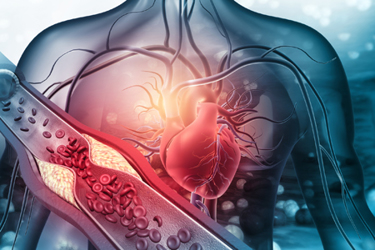A Risk-Based Approach To Assess Particulate Generation For Cardiovascular Devices
By Andrew C. Rau, Cristina Rodriguez Quijada, Ryan Wade, and Collin T. Stabler

Implantable and interventional cardiovascular devices are widely used for diagnostic and therapeutic medical procedures. The therapeutic and/or diagnostic intended uses of these devices are broad, and the total length of time that a device remains within the cardiovascular system can range from the patient’s remaining lifetime (years) to mere minutes during a diagnostic procedure. These devices can pose inherent risks to patients, including potential risks associated with particulate matter generated by a device and introduced into the circulatory system. Particulate matter can be deposited onto the surface of vascular devices from the manufacturing process, assembly, and/or packaging. This particulate matter can be liberated during the clinical use of the device. Particulate matter can also be liberated from the device coating or device itself due to internal wear or friction between a device and accessories or a device and the patient’s anatomy.
As described in U.S. FDA guidance documents, potential adverse events associated with particulate generation and/or introduction include pulmonary embolism, pulmonary infarction, myocardial embolism, myocardial infarction, embolic stroke, tissue necrosis, and death.1 The type, quantity, and characteristics of the particulate can affect the resulting risk profile and the adverse events associated with the devices. For example, studies have reported that particulates introduced during percutaneous coronary intervention (PCI) could lead to local foreign body inflammatory and/or thrombogenic response such as granuloma formation,2 or systemic complications such as mechanical obstruction of microvessels (i.e., arterioles or capillaries).3,4
Cardiovascular devices can incorporate coatings to achieve sufficient lubricity, drug delivery, or other performance requirements. The FDA has recognized that separation of coatings from intravascular medical devices can pose a safety concern,5 and current regulatory guidance documents acknowledge the risks associated with particulates from such devices.6,7 These guidance documents provide some general recommendations for characterizing those particulates. However, guidance on how the results of particulate evaluations should be interpreted to inform the device risk profile is not provided, thereby requiring device manufacturers to develop internal methods and scientific justifications to be used within regulatory submissions to FDA. Consequently, it is important to determine how particulate generation affects the risk profile for your cardiovascular devices.
Existing Guidance And Best Practices
Evaluation of Particulate Quantity and Size
FDA guidance documents for stents and catheters state that the total quantity and size of particulates liberated during use of a device can be used as indicators of embolic risk, and the FDA therefore recommends that the total number and size of particulates be measured in preclinical testing during simulated use and device deployment.8,9 For coronary angioplasty catheters, the FDA recommends reporting particulate counts in specific size ranges: ≥10 µm, ≥25 µm, and ≥50 µm, and includes recommendations and requirements for validating the particulate recovery rates of the test system.
Existing Particulate Acceptance Criteria
The particulate size ranges ≥10 µm and ≥25 µm recommended in the coronary angioplasty catheter FDA guidance document correspond to the size ranges used in USP <788>, which defines acceptance criteria for particulate matter in injections.10 The fact that these size categories are identical and that no explicit acceptance criteria for particulate size counts exist for cardiovascular devices has led some manufacturers to use the acceptance requirements in USP <788> for particulate matter generation for cardiovascular devices. However, the requirements provided in USP <788> are specifically intended for injectable solutions, not for implantable or diagnostic vascular devices. A technical information report developed by the Association for the Advancement of Medical Instrumentation, titled Evaluation of particulates associated with vascular medical devices (AAMI TIR42:2010), does acknowledge that the limits for small volume injections from USP <788> have been commonly applied to medical devices, but the document does not provide any commentary on the relevance of that approach.11
AAMI TIR42:2010 also discusses that identity, shape, quantity, and final treatment location will all affect the allowable limits for particulates generated from cardiovascular devices and acknowledges that different limits/requirements for particulates will apply to particles emanating from distinct sources (e.g., manufacturing processes, packaging, aging, degradation, and use of the device). AAMI TIR42:2010 further states that the “absence of comprehensive and definitive clinical data” precludes recommendations for allowable particle size ranges and count limits.
Proposed Approach
When evaluating the risks associated with particulates generated by or introduced due to the use of a cardiovascular device, the characteristics of the particulates (e.g., size, shape, etc.) and the anatomical location should be considered. In addition to the previously described measurements of particulate counts within preestablished size categories,12,13 understanding of the shape, composition, anatomical location, treatment site, and time of residence is also relevant to evaluating the complete risk profile.14 For example, scientific literature reports that different physicochemical properties of nanoparticles (e.g., size, shape, surface charge, and surface composition and coating) affect the immune response and toxicological effects and lead to distinct residence times and biodistributions in the body. 15,16,17,18,19,20 In addition, fibers (particles with an aspect ratio ≥10:1) are known to induce a biological response that is vastly different from similarly-sized round particles, and the risk of the formation of emboli due to particulates varies between the intracranial and the peripheral vasculature.21 Surface treatments and coatings can also affect the in vivo toxicological response. For instance, particles coated with polyethylene glycol have longer circulation times since they can escape the reticuloendothelial system.22 Similarly, the risk profile of particulates that are likely to remain in the peripheral vasculature will differ from the risk profile of those that will reside in coronary arteries following a coronary angioplasty procedure. Consequently, the European Commission’s Scientific Committee on Emerging and Newly Identified Health Risks (SCENIHR) has proposed different tests to characterize the physicochemical properties of particles (i.e., wear debris).23
Given the multitude of factors that affect the risk profile of any particulate-generating intravascular medical device, identifying acceptable limits and determining how introduction of those particulates may affect patient health can be difficult. One strategy for understanding and/or mitigating risk is to compare the characteristics of particulates generated from similar devices or from devices that are used in similar anatomical locations. This approach can be challenging and costly, as devices may need to be externally procured and experimentally evaluated, and appropriate devices for comparison may not be readily available.
Regarding methods for physiochemical characterization, guidance documents suggest different techniques, including chemical composition (e.g., MS, ICP-MS, FTIR, NMR, GC/LC-MS), size and shape (e.g., DLS, NTA, AFM, SEM), concentration (e.g., ICP-MS, HPLC, UV-vis), surface charge (e.g., zeta potential), and surface chemistry (e.g., MS, FTIR, NMR, SERS), among others.24
If risks associated with particulates are identified, a combination of the methods discussed previously for physiochemical characterization may be appropriate to characterize those particulates. The characterization method(s) which will be most appropriate for a given scenario will depend on the specifics of the risks identified; e.g., if metallic particulates are identified as a risk, then ICP-MS may be useful for evaluating elemental composition, whereas, FTIR may be more appropriate for characterizing polymeric particulates. The results of those evaluations can be used in toxicological risk assessments of the subject product.
References
- Coronary, Peripheral, and Neurovascular Guidewires – Performance Tests and Recommended Labeling, Guidance for Industry and Food and Drug Administration Staff. Document Issued October 10, 2019.
- Whelan DM, van Beusekom HMM, and van der Giessen WJ. Foreign body contamination during stent implantation. Cath Cardiov Diag, 40:328–32, 1997.
- Orenstein JM, Sato N, Aaron B, Buchholz B, and Bloom S. Microemboli observed in deaths following cardiopulmonary bypass surgery: Silicone antifoam agents and polyvinyl chloride tubing as sources of emboli. Hum Pathol, 13(12):1082–90, 1982.
- Barnwell SL, D’Agostino AN, Shapiro SL, Nesbit GM, and Kellogg JX. Foreign bodies in small arteries after use of an infusion microcatheter. AJNR, 18:1886–89, 1997.
- Lubricious Coating Separation from Intravascular Medical Devices: FDA Safety Communication. Dated: November 23, 2015. http://wayback.archive-it.org/7993/20170722215712/https://www.fda.gov/MedicalDevices/Safety/AlertsandNotices/ucm
473794.htm. Last accessed June 7, 2023. - Coronary, Peripheral, and Neurovascular Guidewires – Performance Tests and Recommended Labeling, Guidance for Industry and Food and Drug Administration Staff. Document Issued October 10, 2019.
- Certain Percutaneous Transluminal Coronary Angioplasty (PTCA) Catheters - Class II Special Controls Guidance for Industry and FDA. Document issued on September 8, 2010.
- Guidance for Industry and FDA Staff: Non-Clinical Engineering Tests and Recommended Labeling for Intravascular Stents and Associated Delivery Systems.
- Class II Special Controls Guidance for Industry and FDA: Certain Percutaneous Transluminal Coronary Angioplasty (PTCA) Catheters. Issued May 30, 2008. https://www.fda.gov/medical-devices/guidance-documents-medical-devices-and-radiation-emitting-products/certain-percutaneous-transluminal-coronary-angioplasty-ptca-catheters-class-ii-special-controls. Last accessed June 8, 2023.
- United States Pharmacopeia 31 and National Formulary 26. <788> Particulate matter in injections. Rockville, MD: United States Pharmacopeial Convention, Inc.; 2008.
- AAMI TIR42:2010, Evaluation of particulates associated with vascular medical devices. Dated: 13 December 2010.
- Guidance for Industry and FDA Staff: Non-Clinical Engineering Tests and Recommended Labeling for Intravascular Stents and Associated Delivery Systems.
- Class II Special Controls Guidance for Industry and FDA: Certain Percutaneous Transluminal Coronary Angioplasty (PTCA) Catheters. Issued May 30, 2008. https://www.fda.gov/medical-devices/guidance-documents-medical-devices-and-radiation-emitting-products/certain-percutaneous-transluminal-coronary-angioplasty-ptca-catheters-class-ii-special-controls. Last accessed June 8, 2023.
- AAMI TIR42:2010, Evaluation of particulates associated with vascular medical devices. Dated: 13 December 2010.
- Opinion on the Guidance on the Determination of Potential Health Effects of Nanomaterials Used in Medical Devices. Scientific Committee on Emerging and Newly Identified Health Risks (SCENIHR). January 6, 2015.
- Baranov, M. V., et al. 2020. Modulation of Immune Responses by Particle Size and Shape. Front Immunol 11:607945.
- Zhao, Y., et al. 2017. A comparison between sphere and rod nanoparticles regarding their in vivo biological behavior and pharmacokinetics. Sci Rep 7(1):4131.
- Mitchell, M. J., et al. 2021. Engineering precision nanoparticles for drug delivery. Nat Rev Drug Discov 20(2):101-124.
- De Matteis, V. 2017. Exposure to Inorganic Nanoparticles: Routes of Entry, Immune Response, Biodistribution and In Vitro/In Vivo Toxicity Evaluation. Toxics 5(4).
- Riediker, M., et al. 2019. Particle toxicology and health - where are we? Part Fibre Toxicol 16(1):19; Riediker, M., et al. 2019. Correction to: Particle toxicology and health - where are we? Part Fibre Toxicol 16(1):26.
- AAMI TIR42:2010, Evaluation of particulates associated with vascular medical devices. Dated: 13 December 2010.
- Mitchell, M. J., et al. 2021. Engineering precision nanoparticles for drug delivery. Nat Rev Drug Discov 20(2):101-124.
- Opinion on the Guidance on Determination of Potential Health Effects of Nanomaterials Used in Medical Devices. Scientific Committee on Emerging and Newly Identified Health Risks (SCENIHR). January 6, 2015.
- Opinion on the Guidance on Determination of Potential Health Effects of Nanomaterials Used in Medical Devices. Scientific Committee on Emerging and Newly Identified Health Risks (SCENIHR). January 6, 2015.
 About The Authors:
About The Authors:
Andrew Rau, P.E., is a senior managing engineer in Exponent’s Biomedical Engineering & Sciences Practice. He specializes in the evaluation and failure analysis of medical devices, drug delivery products, and combination products.
 Christina Rodriguez Quijada, Ph.D., is a senior scientist in Exponent’s Biomedical Engineering & Sciences Practice. She has experience with device design and failure investigations and has extensive knowledge related to nanoparticle characterization techniques.
Christina Rodriguez Quijada, Ph.D., is a senior scientist in Exponent’s Biomedical Engineering & Sciences Practice. She has experience with device design and failure investigations and has extensive knowledge related to nanoparticle characterization techniques.
 Ryan Wade, Ph.D., is a senior manager in Exponent’s Biomedical Engineering & Sciences Practice and adjunct faculty in the School of Biomedical Engineering, Science and Health Systems at Drexel University. He has broad experience in the evaluation of material manufacturing processes, materials characterization, and failure analysis of various materials including pharmaceutical, plastic, and rubber components.
Ryan Wade, Ph.D., is a senior manager in Exponent’s Biomedical Engineering & Sciences Practice and adjunct faculty in the School of Biomedical Engineering, Science and Health Systems at Drexel University. He has broad experience in the evaluation of material manufacturing processes, materials characterization, and failure analysis of various materials including pharmaceutical, plastic, and rubber components.
 Collin Stabler, Ph.D., P.E., is a senior managing engineer in Exponent’s Biomedical Engineering & Sciences Practice. He has extensive expertise in biotechnology evaluation, from product conceptualization through regulatory strategy. His experience centers around the intersection of mechanical performance and biocompatibility.
Collin Stabler, Ph.D., P.E., is a senior managing engineer in Exponent’s Biomedical Engineering & Sciences Practice. He has extensive expertise in biotechnology evaluation, from product conceptualization through regulatory strategy. His experience centers around the intersection of mechanical performance and biocompatibility.
